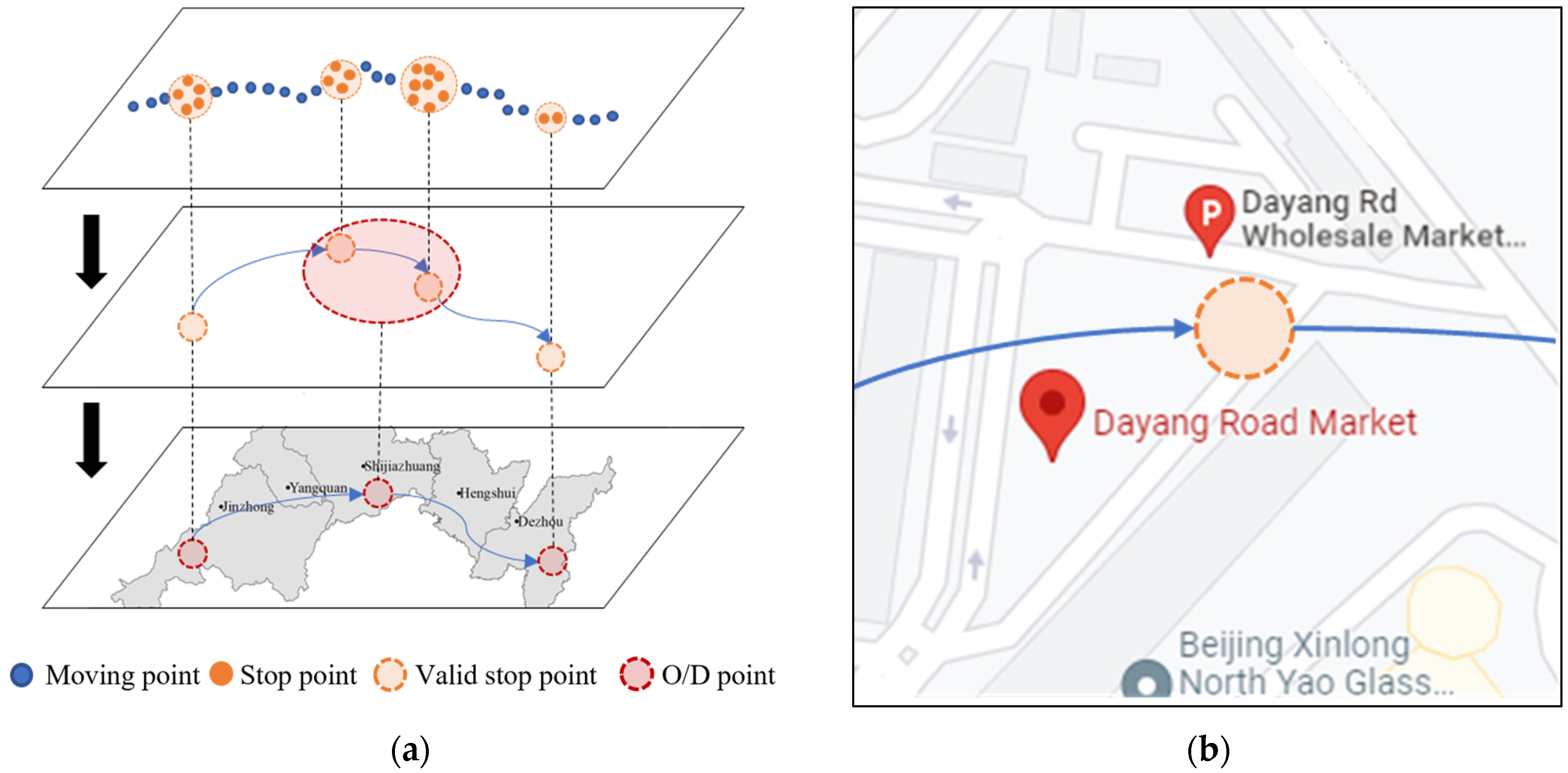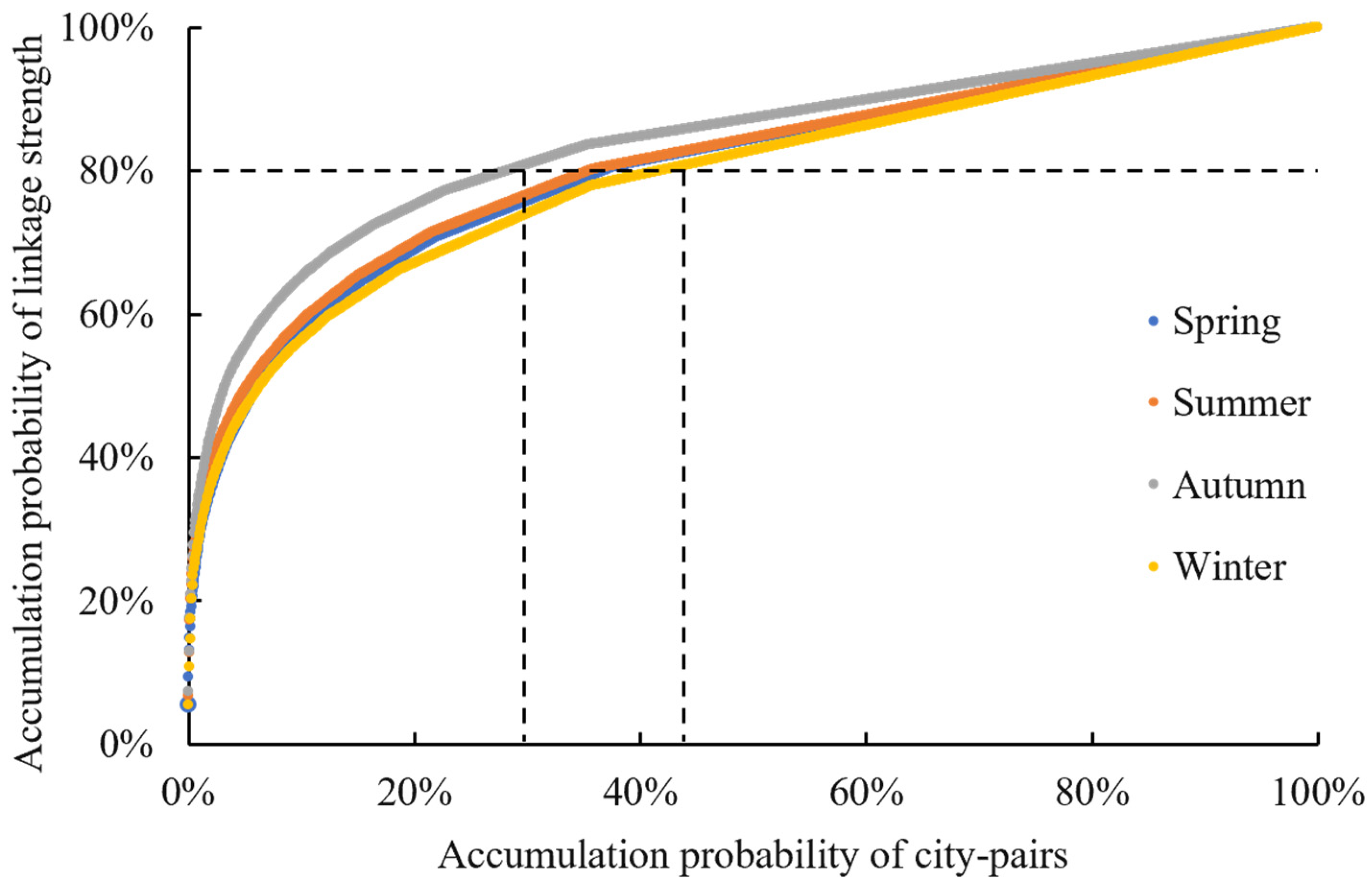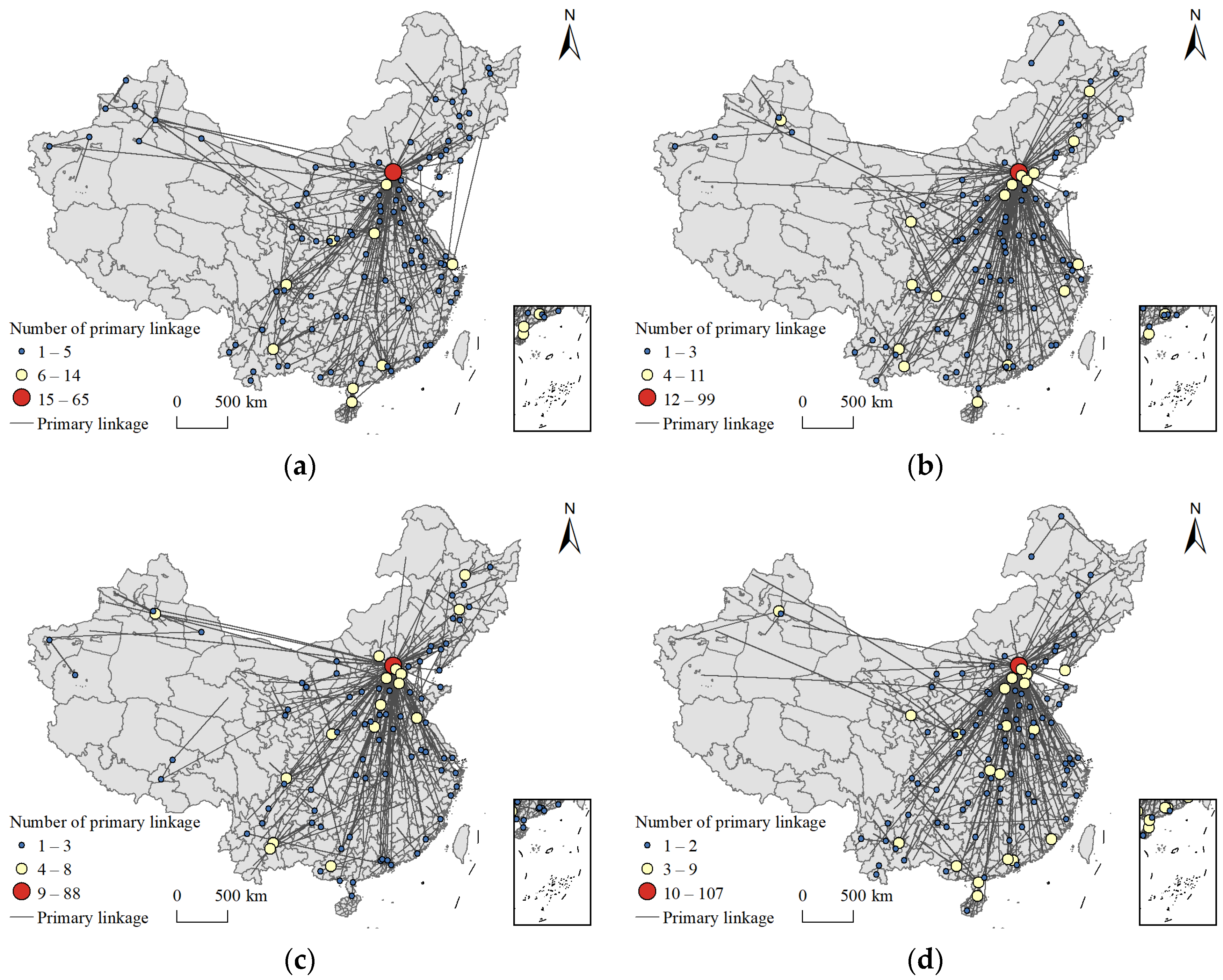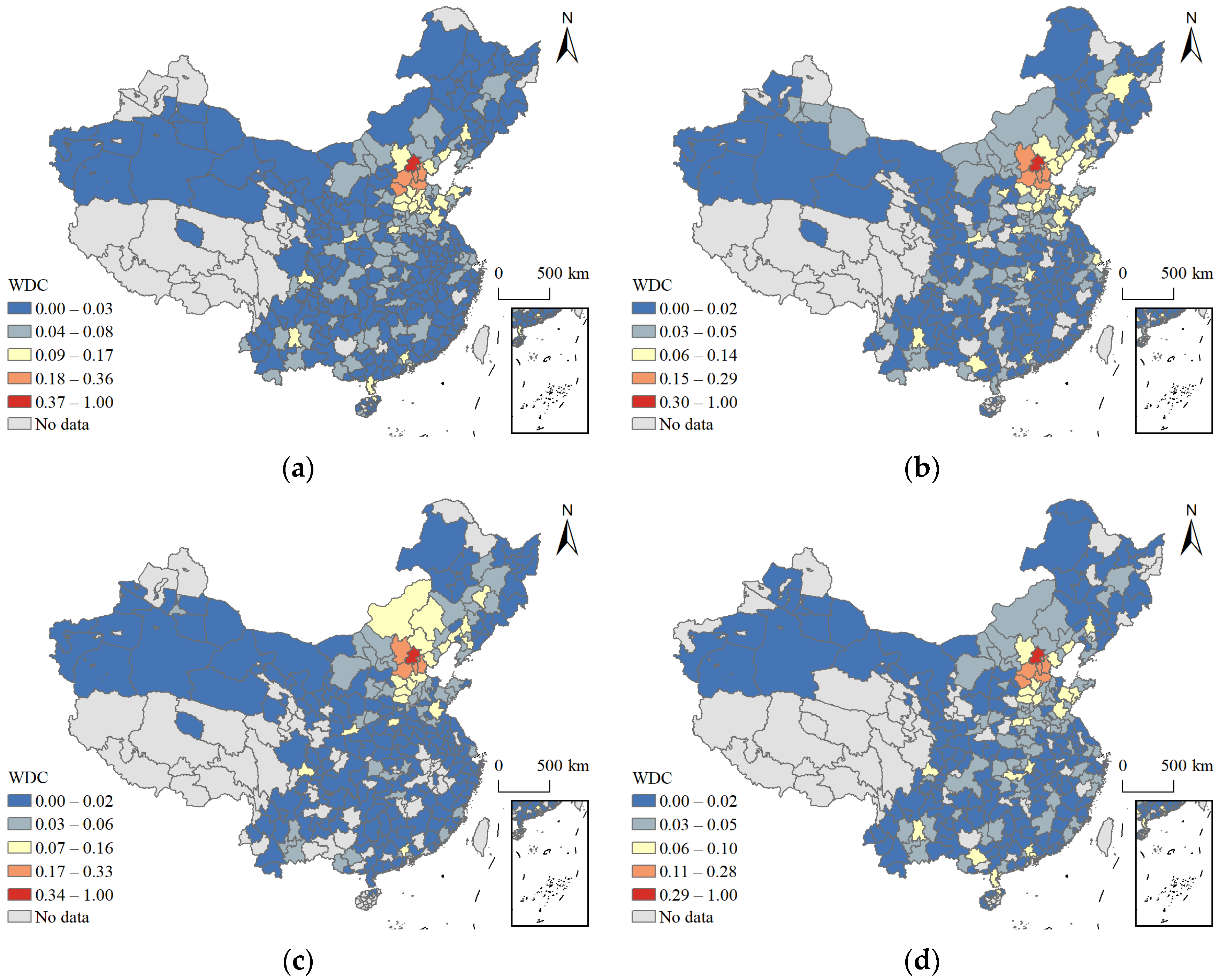Seasonal Characteristics of Agricultural Product Circulation Network: A Case Study in Beijing, China
Abstract
1. Introduction
2. Materials and Methods
2.1. Study Area and Data Acquisition
2.2. Data Processing
2.2.1. Identification of Valid Stop Points
2.2.2. Semantic Tagging of Trip Chain
2.2.3. Extraction of Trip Chains Related to Agricultural Product Circulation
2.2.4. Construction of Intercity Origin–Destination (O-D) Sequences
2.2.5. Network Construction
2.3. Analysis Methods
2.3.1. Weighted Degree Centrality
2.3.2. Network Hierarchy Metrics
2.3.3. Clustering Coefficient
2.3.4. Coefficient of Variation
3. Results
3.1. Macro-View: Network
3.2. Meso-View: Edges
3.3. Micro-View: Nodes
4. Discussion
4.1. Methodological Contribution
4.2. Results and Significance
4.3. Limitations and Future Directions
5. Conclusions
- (1)
- The method proposed in this study to extract the trip chain of agricultural product circulation based on trajectory data can dynamically adjust the spatiotemporal refinement according to the analysis demand, which provides a favorable analytical tool for the study of an agricultural product circulation system.
- (2)
- From the macro-view, the agricultural product circulation networks in Beijing exhibit an obvious hierarchical and radial structure. The core/periphery fit of the networks is over 0.92. The network density in south China is higher in winter and spring than in summer and autumn, whereas the northeast and northwest regions are the opposite.
- (3)
- From the meso-view, 80% of the linkage strength is concentrated on 35.3% of city-pairs, where the agglomeration effect and hub status of the linking cities is more prominent in summer and autumn.
- (4)
- From the micro-view, a total of 316 cities form Beijing agricultural product circulation networks, 9.4% of which are core cities, located around Beijing, contributing 59.7% of the flow to Beijing agricultural product circulation. A total of 48.1% of cities are mainly served by Beijing agricultural product circulation in winter and spring, which is 2.7 times more than cities served in summer and autumn. These cities contribute 27.4% of the flow to Beijing agricultural product circulation, which is twice as much as cities served in summer and autumn.
Author Contributions
Funding
Data Availability Statement
Acknowledgments
Conflicts of Interest
References
- Liu, X.; Zeng, F. Poverty Reduction in China: Does the Agricultural Products Circulation Infrastructure Matter in Rural and Urban Areas? Agriculture 2022, 12, 1208. [Google Scholar] [CrossRef]
- Constantin, M.; Sacală, M.-D.; Dinu, M.; Piștalu, M.; Pătărlăgeanu, S.R.; Munteanu, I.-D. Vegetable Trade Flows and Chain Competitiveness Linkage Analysis Based on Spatial Panel Econometric Modelling and Porter’s Diamond Model. Agronomy 2022, 12, 411. [Google Scholar] [CrossRef]
- MacDonald, G.K. Eating on an interconnected planet. Environ. Res. Lett. 2013, 8, 021002. [Google Scholar] [CrossRef]
- Zhao, C.; Liu, B.; Piao, S.; Wang, X.; Lobell, D.B.; Huang, Y.; Huang, M.; Yao, Y.; Bassu, S.; Ciais, P. Temperature increase reduces global yields of major crops in four independent estimates. Proc. Natl. Acad. Sci. USA 2017, 114, 9326–9331. [Google Scholar] [CrossRef]
- Majerova, J.; Sroka, W.; Krizanova, A.; Gajanova, L.; Lazaroiu, G.; Nadanyiova, M. Sustainable brand management of alimentary goods. Sustainability 2020, 12, 556. [Google Scholar] [CrossRef]
- MacDonald, G.K.; Brauman, K.A.; Sun, S.; Carlson, K.M.; Cassidy, E.S.; Gerber, J.S.; West, P.C. Rethinking agricultural trade relationships in an era of globalization. BioScience 2015, 65, 275–289. [Google Scholar] [CrossRef]
- Lowder, S.K.; Skoet, J.; Raney, T. The number, size, and distribution of farms, smallholder farms, and family farms worldwide. World Dev. 2016, 87, 16–29. [Google Scholar] [CrossRef]
- Schweitzer, F.; Fagiolo, G.; Sornette, D.; Vega-Redondo, F.; Vespignani, A.; White, D.R. Economic networks: The new challenges. Science 2009, 325, 422–425. [Google Scholar] [CrossRef]
- Dalin, C.; Konar, M.; Hanasaki, N.; Rinaldo, A.; Rodriguez-Iturbe, I. Evolution of the global virtual water trade network. Proc. Natl. Acad. Sci. USA 2012, 109, 5989–5994. [Google Scholar] [CrossRef]
- Zsigmond, T.; Zsigmondová, A.; Machová, R. What makes the rural area resilient? In Proceedings of the 21st International Joint Conference Central and Eastern Europe in the Changing Business Environment, Prague, Czech Republic, 20–21 May 2021; pp. 313–322. [Google Scholar]
- Fernandez-Mena, H.; Gaudou, B.; Pellerin, S.; MacDonald, G.K.; Nesme, T. Flows in Agro-food Networks (FAN): An agent-based model to simulate local agricultural material flows. Agric. Syst. 2020, 180, 102718. [Google Scholar] [CrossRef]
- Konar, M.; Lin, X.; Ruddell, B.; Sivapalan, M. Scaling properties of food flow networks. PLoS ONE 2018, 13, e0199498. [Google Scholar] [CrossRef] [PubMed]
- Sun, Q.; Hou, M.; Shi, S.; Cui, L.; Xi, Z. The Influence of Country Risks on the International Agricultural Trade Patterns Based on Network Analysis and Panel Data Method. Agriculture 2022, 12, 361. [Google Scholar] [CrossRef]
- Qiang, W.; Niu, S.; Wang, X.; Zhang, C.; Liu, A.; Cheng, S. Evolution of the global agricultural trade network and policy implications for China. Sustainability 2019, 12, 192. [Google Scholar] [CrossRef]
- Zhou, L.; Tong, G. Structural Evolution and Sustainability of Agricultural Trade between China and Countries along the “Belt and Road”. Sustainability 2022, 14, 9512. [Google Scholar] [CrossRef]
- Ya, Z.; Pei, K. Factors Influencing Agricultural Products Trade between China and Africa. Sustainability 2022, 14, 5589. [Google Scholar] [CrossRef]
- Yang, J.; Wang, J.; Xu, C.; Liu, Y.; Yin, Q.; Wang, X.; Wang, L.; Wu, Y.; Xiao, G. Rice supply flows and their determinants in China. Resour. Conserv. Recycl. 2021, 174, 105812. [Google Scholar] [CrossRef]
- Abula, K.; Abula, B.; Hu, Q.; Chen, X.; Wang, D. Research on the High-Quality Development Path of the Cross-Border Agricultural Product Supply Chain between China and Central Asia. Agronomy 2022, 12, 2558. [Google Scholar] [CrossRef]
- Tuninetti, M.; Ridolfi, L.; Laio, F. Charting out the future agricultural trade and its impact on water resources. Sci. Total Environ. 2020, 714, 136626. [Google Scholar] [CrossRef]
- Ali, T.; Huang, J.; Wang, J.; Xie, W. Global footprints of water and land resources through China’s food trade. Glob. Food Secur. 2017, 12, 139–145. [Google Scholar] [CrossRef]
- Meyfroidt, P.; Lambin, E.F.; Erb, K.-H.; Hertel, T.W. Globalization of land use: Distant drivers of land change and geographic displacement of land use. Curr. Opin. Env. Sust. 2013, 5, 438–444. [Google Scholar] [CrossRef]
- Lee, D.; Yang, S.-G.; Kim, K.; Kim, B.J. Product flow and price change in an agricultural distribution network. Physica A 2018, 490, 70–76. [Google Scholar] [CrossRef]
- Hamilton, H.A.; Ivanova, D.; Stadler, K.; Merciai, S.; Schmidt, J.; Van Zelm, R.; Moran, D.; Wood, R. Trade and the role of non-food commodities for global eutrophication. Nat. Sustain. 2018, 1, 314–321. [Google Scholar] [CrossRef]
- Tuninetti, M.; Tamea, S.; Dalin, C. Water debt indicator reveals where agricultural water use exceeds sustainable levels. Water Resour. Res. 2019, 55, 2464–2477. [Google Scholar] [CrossRef]
- Schmitz, C.; Biewald, A.; Lotze-Campen, H.; Popp, A.; Dietrich, J.P.; Bodirsky, B.; Krause, M.; Weindl, I. Trading more food: Implications for land use, greenhouse gas emissions, and the food system. Glob. Environ. Chang. 2012, 22, 189–209. [Google Scholar] [CrossRef]
- Liu, J.; Mooney, H.; Hull, V.; Davis, S.J.; Gaskell, J.; Hertel, T.; Lubchenco, J.; Seto, K.C.; Gleick, P.; Kremen, C. Systems integration for global sustainability. Science 2015, 347, 1258832. [Google Scholar] [CrossRef] [PubMed]
- Dalin, C.; Qiu, H.; Hanasaki, N.; Mauzerall, D.L.; Rodriguez-Iturbe, I. Balancing water resource conservation and food security in China. Proc. Natl. Acad. Sci. USA 2015, 112, 4588–4593. [Google Scholar] [CrossRef]
- Sartori, M.; Schiavo, S. Connected we stand: A network perspective on trade and global food security. Food Policy 2015, 57, 114–127. [Google Scholar] [CrossRef]
- Carr, J.A.; D’Odorico, P.; Laio, F.; Ridolfi, L. Recent history and geography of virtual water trade. PLoS ONE 2013, 8, e55825. [Google Scholar] [CrossRef]
- Lin, X.; Ruess, P.J.; Marston, L.; Konar, M. Food flows between counties in the United States. Environ. Res. Lett. 2019, 14, 084011. [Google Scholar] [CrossRef]
- Karakoc, D.B.; Wang, J.; Konar, M. Food flows between counties in the United States from 2007 to 2017. Environ. Res. Lett. 2022, 17, 034035. [Google Scholar] [CrossRef]
- Smith, T.M.; Goodkind, A.L.; Kim, T.; Pelton, R.E.; Suh, K.; Schmitt, J. Subnational mobility and consumption-based environmental accounting of US corn in animal protein and ethanol supply chains. Proc. Natl. Acad. Sci. USA 2017, 114, E7891–E7899. [Google Scholar] [CrossRef] [PubMed]
- Fair, K.R.; Bauch, C.T.; Anand, M. Dynamics of the global wheat trade network and resilience to shocks. Sci. Rep. 2017, 7, 7177. [Google Scholar] [CrossRef] [PubMed]
- Ercsey-Ravasz, M.; Toroczkai, Z.; Lakner, Z.; Baranyi, J. Complexity of the international agro-food trade network and its impact on food safety. PLoS ONE 2012, 7, e37810. [Google Scholar] [CrossRef]
- Sun, J.; Mooney, H.; Wu, W.; Tang, H.; Tong, Y.; Xu, Z.; Huang, B.; Cheng, Y.; Yang, X.; Wei, D. Importing food damages domestic environment: Evidence from global soybean trade. Proc. Natl. Acad. Sci. USA 2018, 115, 5415–5419. [Google Scholar] [CrossRef]
- Sibhatu, K.T.; Qaim, M. Rural food security, subsistence agriculture, and seasonality. PLoS ONE 2017, 12, e0186406. [Google Scholar] [CrossRef]
- Lobell, D.B.; Schlenker, W.; Costa-Roberts, J. Climate trends and global crop production since 1980. Science 2011, 333, 616–620. [Google Scholar] [CrossRef]
- Wen, L.; Song, Q. Simulation study on carbon emission of China’s freight system under the target of carbon peaking. Sci. Total Environ. 2022, 812, 152600. [Google Scholar] [CrossRef]
- Cheng, S.; Zhang, B.; Peng, P.; Yang, Z.; Lu, F. Spatiotemporal evolution pattern detection for heavy-duty diesel truck emissions using trajectory mining: A case study of Tianjin, China. J. Clean. Prod. 2020, 244, 118654. [Google Scholar] [CrossRef]
- Cheng, S.; Lu, F.; Peng, P. A high-resolution emissions inventory and its spatiotemporal pattern variations for heavy-duty diesel trucks in Beijing, China. J. Clean. Prod. 2020, 250, 119445. [Google Scholar] [CrossRef]
- Han, Y.; Yang, L.; Jia, K.; Li, J.; Feng, S.; Chen, W.; Zhao, W.; Pereira, P. Spatial distribution characteristics of the COVID-19 pandemic in Beijing and its relationship with environmental factors. Sci. Total Environ. 2021, 761, 144257. [Google Scholar] [CrossRef] [PubMed]
- Siripirote, T.; Sumalee, A.; Ho, H. Statistical estimation of freight activity analytics from Global Positioning System data of trucks. Transport. Res. E-Log. 2020, 140, 101986. [Google Scholar] [CrossRef]
- Yang, Y.; Jia, B.; Yan, X.-Y.; Li, J.; Yang, Z.; Gao, Z. Identifying intercity freight trip ends of heavy trucks from GPS data. Transport. Res. E-Log. 2022, 157, 102590. [Google Scholar] [CrossRef]
- Zhu, Z.; Ren, H.; Ruan, S.; Han, B.; Bao, J.; Li, R.; Li, Y.; Zheng, Y. Icfinder: A ubiquitous approach to detecting illegal hazardous chemical facilities with truck trajectories. In Proceedings of the 29th International Conference on Advances in Geographic Information Systems, Beijing, China, 2–5 November 2021; pp. 37–40. [Google Scholar]
- Gingerich, K.; Maoh, H.; Anderson, W. Classifying the purpose of stopped truck events: An application of entropy to GPS data. Transport. Res. C-Emer. 2016, 64, 17–27. [Google Scholar] [CrossRef]
- Sarti, L.; Bravi, L.; Sambo, F.; Taccari, L.; Simoncini, M.; Salti, S.; Lori, A. Stop purpose classification from GPS data of commercial vehicle fleets. In Proceedings of the 2017 IEEE International Conference on Data Mining Workshops (ICDMW), New Orleans, LA, USA, 18–21 November 2017; pp. 280–287. [Google Scholar]
- Jia, X.; Huang, J.; Xu, Z. Marketing of farmer professional cooperatives in the wave of transformed agrofood market in China. China Econ. Rev. 2012, 23, 665–674. [Google Scholar] [CrossRef]
- Jiao, J.; Wang, J.; Jin, F. Impacts of high-speed rail lines on the city network in China. J. Transp. Geogr. 2017, 60, 257–266. [Google Scholar] [CrossRef]
- Zipf, G.K. Human Behavior and the Principle of Least Effort: An Introduction to Human Ecology; Ravenio Books: Norris, MT, USA, 2016. [Google Scholar]
- Chen, W.; Liu, W.; Ke, W.; Wang, N. Understanding spatial structures and organizational patterns of city networks in China: A highway passenger flow perspective. J. Geogr. Sci. 2018, 28, 477–494. [Google Scholar] [CrossRef]
- Yang, L.; Wang, J.; Yang, Y. Spatial evolution and growth mechanism of urban networks in western China: A multi-scale perspective. J. Geogr. Sci. 2022, 32, 517–536. [Google Scholar] [CrossRef]
- Newman, M.E. The structure and function of complex networks. SIAM Rev. 2003, 45, 167–256. [Google Scholar] [CrossRef]
- Li, T.; Wang, J.; Huang, J.; Gao, X. Exploring temporal heterogeneity in an intercity travel network: A comparative study between weekdays and holidays in China. J. Geogr. Sci. 2020, 30, 1943–1962. [Google Scholar] [CrossRef]
- Qiang, W.; Niu, S.; Liu, A.; Kastner, T.; Bie, Q.; Wang, X.; Cheng, S. Trends in global virtual land trade in relation to agricultural products. Land Use Policy 2020, 92, 104439. [Google Scholar] [CrossRef]
- Campi, M.; Duenas, M.; Fagiolo, G. How do countries specialize in agricultural production? A complex network analysis of the global agricultural product space. Environ. Res. Lett. 2020, 15, 124006. [Google Scholar] [CrossRef]
- Wang, L.; Anna, H.; Zhang, L.; Xiao, Y.; Wang, Y.; Xiao, Y.; Liu, J.; Ouyang, Z. Spatial and temporal changes of arable land driven by urbanization and ecological restoration in China. Chin. Geogr. Sci. 2019, 29, 809–819. [Google Scholar] [CrossRef]
- Zhang, X.; Liu, Y.; Liu, Y.; Cui, Q.; Yang, L.; Hu, X.; Guo, J.; Zhang, J.; Yang, S. Impacts of climate change on self-sufficiency of rice in China: A CGE-model-based evidence with alternative regional feedback mechanisms. J. Clean. Prod. 2019, 230, 150–161. [Google Scholar] [CrossRef]







| POI/AOI Name | POI/AOI Type | Activity Purpose |
|---|---|---|
| Shouguang Agricultural Products Logistics Park | Industrial Park | Work |
| Wensheng Home | Residential Area | Rest |
| Beijing Dayang Road Agricultural Products Market | Comprehensive Market | Work |
| Season | Number of Cities | Freight Scale 1 | Goodness-of-Fit (R2) | Core/Periphery Fit | |||||
|---|---|---|---|---|---|---|---|---|---|
| Spring | 305 | 6945 | 20.50 | 825.23 | 1.20 | 1.11 | 0.83 | 0.92 | 0.38 |
| Summer | 295 | 5587 | 21.83 | 845.29 | 1.25 | 1.12 | 0.86 | 0.95 | 0.36 |
| Autumn | 284 | 6541 | 23.97 | 904.85 | 1.24 | 1.21 | 0.89 | 0.96 | 0.36 |
| Winter | 290 | 4460 | 18.75 | 742.53 | 1.25 | 1.11 | 0.87 | 0.93 | 0.34 |
| Season | Number of Primary Liking Cities | Average Number of Linked Cities |
|---|---|---|
| Spring | 103 | 3.05 |
| Summer | 93 | 3.20 |
| Autumn | 94 | 3.09 |
| Winter | 103 | 2.80 |
| Season | Global Moran’s I Index | Z-Score | p-Value |
|---|---|---|---|
| Spring | 0.21 | 20.05 | <0.001 |
| Summer | 0.23 | 18.34 | <0.001 |
| Autumn | 0.26 | 18.90 | <0.001 |
| Winter | 0.19 | 16.32 | <0.001 |
Publisher’s Note: MDPI stays neutral with regard to jurisdictional claims in published maps and institutional affiliations. |
© 2022 by the authors. Licensee MDPI, Basel, Switzerland. This article is an open access article distributed under the terms and conditions of the Creative Commons Attribution (CC BY) license (https://creativecommons.org/licenses/by/4.0/).
Share and Cite
Zhao, Y.; Cheng, S.; Lu, F. Seasonal Characteristics of Agricultural Product Circulation Network: A Case Study in Beijing, China. Agronomy 2022, 12, 2827. https://doi.org/10.3390/agronomy12112827
Zhao Y, Cheng S, Lu F. Seasonal Characteristics of Agricultural Product Circulation Network: A Case Study in Beijing, China. Agronomy. 2022; 12(11):2827. https://doi.org/10.3390/agronomy12112827
Chicago/Turabian StyleZhao, Yibo, Shifen Cheng, and Feng Lu. 2022. "Seasonal Characteristics of Agricultural Product Circulation Network: A Case Study in Beijing, China" Agronomy 12, no. 11: 2827. https://doi.org/10.3390/agronomy12112827
APA StyleZhao, Y., Cheng, S., & Lu, F. (2022). Seasonal Characteristics of Agricultural Product Circulation Network: A Case Study in Beijing, China. Agronomy, 12(11), 2827. https://doi.org/10.3390/agronomy12112827







